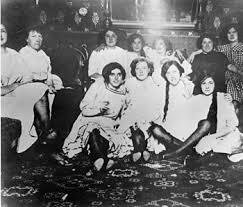The Hero Hooker
jmp.press@gmail.com
History is filled with stories of prostitutes who, despite their low social standing, did inspiring things. The Bible tells about Rahab, who harbored two Israeli spies inside Jericho. Gone With the …
This item is available in full to subscribers.
Subscribe to continue reading. Already a subscriber? Sign in
Get 50% of all subscriptions for a limited time. Subscribe today.
Please log in to continueNeed an account?
|
The Hero Hooker
jmp.press@gmail.com
History is filled with stories of prostitutes who, despite their low social standing, did inspiring things. The Bible tells about Rahab, who harbored two Israeli spies inside Jericho. Gone With the Wind includes Belle Watling, whom some scholars believe was modelled on real-life Kentucky madam Belle Brezing.
And there was Annie Cook, the Hero Hooker of Memphis, Tennessee.
Never heard of her? It’s no surprise; she’s largely unknown outside the Bluff City. But her bravery touched countless hearts in her time.
It all started with a mosquito. That annoying insect was more than just a pest back then; it frequently carried death up the Mississippi River. Science wouldn’t discover until the 1900s that it was responsible for several epidemics, including Yellow Fever.
Spread by mosquito bite, those infected suffered miserable symptoms. They began with a headache followed by chills and fever. The liver and kidneys eventually failed, giving the skin a yellow color and the disease its name. The pain was so intense, people screamed in agony. Death usually took two agonizing weeks. Many who survived its ravages were often left physically and mentally disabled. The Mississippi River Valley was especially susceptible to Yellow Fever.
Which is where Annie Cook enters our story. Given her occupation, it’s likely Annie Cook wasn’t her real name. We know she was born in Ohio in 1840 from German stock. She was also beautiful, both inside and out, for she displayed a kind heart from an early age. Annie worked for a family in Kentucky, where people later recalled her caring for patients during a smallpox outbreak.
When she became involved in prostitution isn’t known. But she apparently learned how to make it pay. She wound up in Memphis after the Civil War operating an upscale brothel called the Mansion House.
Then one day in 1873 came the news everyone living along the Mississippi dreaded: yellow fever was on the loose again. Memphis had experienced epidemics in 1855 and 1867. This one was worse. People evacuated the city. Annie dismissed The Mansion’s working girls to go with them while she stayed behind and nursed the sick.
But that was nothing compared to what happened five years later.
It began in July 1878 when Yellow Fever broke out in Vicksburg, Mississippi, some 250 miles downriver. The Bluff City went into panic mode. The epidemics of ’55, ’67, and ’73 had been progressively worse, and there was good reason to fear this would be the granddaddy of them all.
A quarantine was imposed. Nobody traveling up the Mississippi could get off their steamboat. But that didn’t ease jittery nerves. Some 50,000 people lived in Memphis at the time; more than 20,000 fled. Those who stayed prayed, hoped for the best, and waited. It didn’t take long.
It’s believed a steamboat crew member defied the ban by slipping ashore and eating at a nearby restaurant. On August 13, restaurant owner Kate Bionda became the first victim of Memphis’ Great Yellow Fever Outbreak of 1878.
The disease spread like wildfire. Annie again tended the ailing and opened The mansion for use as a hospital. There was little she could do but wipe feverish brows, hold the hands of the dying and comfort them as they slipped into the Hereafter.
A newspaper reporter heard of Annie’s bravery and featured her in several stories. Soon Americans from coast to coast were reading about the “Hero Hooker.” It was a tiny bright spot in a dark situation. Of the 30,000 people left in the city, 20,000 contracted the disease.
Annie Cook became one of them in late August. Word of her illness swept the nation. The Christian Women of Louisville’s letter to her was published in the local paper: “God speed, dear madam, and when the time comes may the light of a better world guide you to a home beyond.”
That light shined for Annie on September 11 when she joined the more than 5,000 Memphians who died.
The disease disappeared when fall’s first frost killed the mosquitoes. Annie was buried in a simple grave. Later, when life returned to normal in the Bluff City, it was moved to a place of honor in prestigious Elmwood Cemetery. A large monument was erected to her memory in 1979.
Ironically, the selfless sacrifice of a woman whose occupation made her a sinner in many eyes perished fulfilling the teaching of Jesus Christ’s Great Commandment: Love thy neighbor as thyself.
Have comments, questions or suggestions? Email jmp.press@gmail.com .
Keywords
holy cow history, holy cow, mark powell, j mark powellOther items that may interest you







Comments
No comments on this item Please log in to comment by clicking here